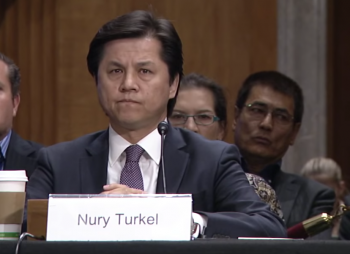It is past time to stop importing Chinese cotton and apparel produced by forced labor in the Uyghur Region

For immediate release
November 7, 2019 11:30 am EST
Contact: Uyghur Human Rights Project +1 (202) 478 1920
UHRP calls on all countries worldwide to stop sales of clothing made in forced-labor factories in the Uyghur Region. A bipartisan group in the U.S. Congress took a noteworthy first step on Tuesday, urging “aggressive action” to ensure strict enforcement of U.S. laws prohibiting forced-labor goods from entering the American marketplace.
The bipartisan November 5 letter to U.S. Customs and Border Protection (CBP), notes that there is “a substantial risk” that apparel or textiles exported from Xinjiang Uyghur Autonomous Region are made with forced labor.
The eight Senators and Representatives called for “all necessary action to ensure that the United States and American consumers are not complicit in the mass surveillance and internment of over one million Uyghurs and other ethnic minority groups in the XUAR, actions which may constitute ‘crimes against humanity.'”
The letter goes on to say that “The risk of forced labor is so great that it is difficult, if not impossible, for companies to conduct appropriate due diligence” regarding their supply chains in the Uyghur Region.
UHRP Board Chair Nury Turkel, in his testimony before an October 17 Congressional-Executive Commission on China (CECC) hearing, noted:
East Turkestan is the source of over 80% of the total cotton produced in China, and the crop is heavily subsidized…. Government documents outline a plan to have at least a million textile industry jobs in the region by 2023. A disturbing picture is thus emerging of the government pushing companies to use cheap or entirely unpaid Uyghur labor.
… and the techno-totalitarian system of surveillance and intimidation put in place by Xinjiang authorities means that corporate supply-chain due diligence is impossible.
At the hearing, titled Forced Labor, Mass Internment, and Social Control in Xinjiang, CECC Co-chair Senator Marco Rubio said in a statement: “Hundreds of thousands, if not millions, of Uyghur men and women have been forced through a military discipline and political reeducation in preparation to take jobs in satellite factories.”
In his statement, CECC Chair Representative James McGovern remarked: “Any U.S. or international company that produces or has a supply chain in Xinjiang may be complicit with forced labor and human rights violations.”
Other groundbreaking research and policy recommendations can be found in the October 16 CSIS report, Connecting the Dots in Xinjiang: Forced Labor, Forced Assimilation, and Western Supply Chains and the Citizen Power Initiatives for China report forming the basis of the authors’ October 15 Wall Street Journal op-ed, Did a Muslim Slave Make Your Chinese Shirt?
On October 17, UHRP joined 36 other human rights organizations urging a ban on the import of all Chinese cotton, textile, and apparel products produced in the Uyghur Region. The joint letter to the CBP reads, in part:
There is significant evidence of China’s systematic use of forced labor in Xinjiang and other parts of the country. This forced labor is used in the production of cotton, textiles, and apparel products, which are being imported into the United States. The undersigned organizations are writing to urge you to issue a Withhold Release Order (“WRO”) against all cotton, textile, and apparel products from China.
…a report entitled, “Cotton: The Fabric Full of Lies: A Report on Forced and Prison Labor in Xinjiang, China, and the Nexus to Global Supply Chains,” uses… data published by the Chinese government, Chinese companies, and witness testimonies to show that China, the world’s largest cotton producer, has built the world’s largest forced labor system to provide the workers needed to sustain its cotton production. This “cotton gulag” is primarily based in Xinjiang, home to most of China’s Uighurs and other Muslim ethnic groups, where 84 percent of China’s cotton output is produced.
In the case of Xinjiang, the evidence is clear. Forced labor is used so ubiquitously throughout Xinjiang that it is difficult to separate Xinjiang’s forced labor economy from its regular economy. And because Xinjiang is by far the major supplier for China’s apparel supply chain, the U.S. government must assume that any cotton products sourced from China are a product of China’s cotton gulag.
